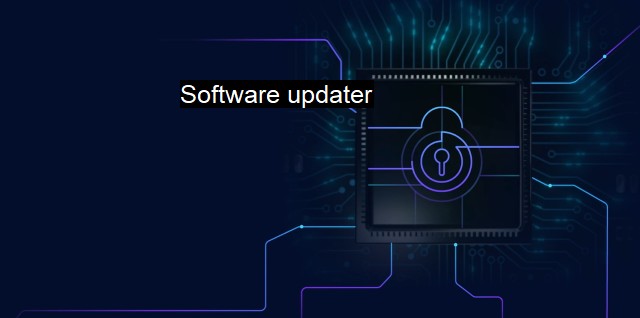What is Software updater?
Staying Ahead of Cyber Threats: The Importance of Antivirus Software and Software Updaters for Digital Asset Protection in Today's Technology-Driven World
A software updater in the context of cybersecurity and antivirus is an essential tool or application that helps maintain the system's integrity and security by addressing vulnerabilities and bugs. This term generally refers to a system or application component that checks for the most recent updates, revisions, and bug fixes from the software's original creator or another trusted source and applies it accordingly.Software plays a critical role in running computers, networks, and devices. It can execute complex computations, establish online connections, and bolster system operations. Therefore keeping software updated carries enormous significance. The process may encompass numerous individual activities, such as identifying new updates availability, verifying their sources, determining appropriate version, and eventually installing these updates.
The proper functioning of software-updating tasks upholds the system's health while also providing meaningful cybersecurity and antivirus protection. Subsequently, this process plugs vulnerability loopholes and helps the system prevent data hacks, lessen the risk of virus infections, decrease potential for malware or ransomware attacks, and ultimately protect sensitive personal or corporate data.
Hackers and cybercriminals relentlessly devise new ways to infringe upon out-of-date systems with known security issues. These vulnerabilities can be exploited and used to inject malicious code, steal sensitive data, or gain unauthorized access or control to the system. Software developers constantly monitor these situations and regularly release updates or patches to fix identified security loopholes or improve the software functionality. Software updater automates this detection and installation process.
When timely software updates are neglected, the system remains exposed to these security risks. Antivirus programs alone may not provide sufficient protection against these threats since their effectiveness is significantly reliant on how updated their database is. Therefore, the combination of both, a reliable antivirus solution and regular software updates gives users a much-needed shield to protect against cyber threats.
A software updater also ensures that all features, services, and utilities of a software keep pace with advancement in related technologies. It helps software to improve and remain on a competitive edge by implementing the most recent breakthroughs, technology standards, algorithms, and methodologies. The overall user experience is enhanced with the system running at its most maximum efficiency, potentially improving performance, speed, reliability, and usability.
Software update can also be crucial for compatibility issues. Different software programs have to seamlessly interact with each other in a system environment; with every upgrade or revision, software maintain their compatibility with others. Sometimes, hardware manufacturers release software or firmware updates that adapt to the technical progression of its hardware product range. Without these updates, hardware and software cannot communicate effectively, leading to potential system failures or decreased system performance.
Regular software updates, thus, assume a critical role in systems’ security. Proper implementation and management of software updates can substantially enhance defense mechanisms against various malicious strategies. manual updating can be a cumbersome, time-consuming task, with a risk of inconsistencies and human errors.
An efficient software updater delivers an automated, structured, and holistic approach to meet a system's updating requirements. It eases the control, observation, application, and management of software updates, giving users peace of mind. The automated nature of most software updaters does not only save time for individuals and organizations, but it democratizes cybersecurity practices by making them accessible even to those with limited technical knowledge.
a software updater in cybersecurity context acts as a proactive defender of system integrity by keeping software systems and applications updated. It serves as a deterrent to cyber threats and boosts the capability of antivirus systems, ensuring that software remains secure and efficient. Regular system and software updates form a strategic approach to continual system security, fostering a secure cyber environment for both personal and corporate users.

Software updater FAQs
What is a software updater?
A software updater is a feature or program that scans your computer for outdated, vulnerable software and updates it to the latest version. It helps keep your computer secure by patching vulnerabilities and fixing bugs that could be exploited by cybercriminals.Why is a software updater important for cybersecurity?
A software updater is important for cybersecurity because outdated software can contain security vulnerabilities that can be exploited by cybercriminals. By regularly updating your software, you can stay protected against these threats and reduce your risk of being compromised.How does a software updater differ from an antivirus program?
A software updater and an antivirus program serve different purposes. A software updater is designed to update software to the latest version to patch vulnerabilities and fix bugs. An antivirus program, on the other hand, is designed to detect and remove malicious software from your computer. While both are important for cybersecurity, they address different aspects of protection.Can a software updater cause problems with my computer?
While software updaters are designed to improve your computer's security and performance, they can cause problems if the updates are not installed correctly. For example, an update can conflict with other software on your computer, causing crashes or errors. To avoid these issues, it's important to make sure that you're using a reputable software updater and that you're following recommended update procedures.| | A | | | B | | | C | | | D | | | E | | | F | | | G | | | H | | | I | | | J | | | K | | | L | | | M | |
| | N | | | O | | | P | | | Q | | | R | | | S | | | T | | | U | | | V | | | W | | | X | | | Y | | | Z | |
| | 1 | | | 2 | | | 3 | | | 4 | | | 7 | | | 8 | | |||||||